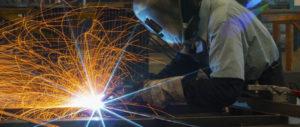In 2025, automation in welding stands at the forefront of industrial transformation, reshaping how electrode production plants worldwide operate. For factory owners, manufacturing engineers, and automation enthusiasts, understanding this technological leap is essential to unlocking higher productivity, quality, and competitiveness. Today, the fusion of robotics and IoT isn’t just innovation—it’s industry necessity.
The Rise of Automation in Welding Electrode Manufacturing
Automated welding systems use programmable robots, precision sensors, and real-time data analytics to execute the entire electrode production cycle—from wire feeding and coating to inspection and packaging. What sets modern automation apart is its blend with the Internet of Things (IoT), enabling machines to communicate, adapt, and optimize processes without constant human oversight.
Key Benefits of Automation in Welding

Consistency & Quality
Robotic systems maintain identical welds and electrode coatings batch after batch, drastically reducing defects and costly rework. Automation ensures that every electrode meets strict industry standards, supporting superior downstream weld performance in construction, automotive, and heavy industry. IoT-enabled sensors measure and automatically correct variables such as feed rate, temperature, and viscosity, keeping quality consistent even as raw materials change.
Productivity & Throughput
Welding robots and automated lines can operate at 90–100% efficiency, compared to just 30% for manual labor. Multiple shifts, fatigue, and breaks are eliminated, while real-time data helps optimize cycle times, eliminate idle periods, and boost overall plant output—even doubling or tripling capacity in many cases.
Worker Safety
Automation in welding removes operators from hazardous fumes, extreme temperatures, and arc flash exposure. Robots now perform complex, high-risk welding, allowing human workers to focus on monitoring and high-value tasks in safer environments.
Cost Savings
Factories see significant reductions in labor costs, material waste, rework, and downtime. Exact parameter control minimizes excess filler wire use, prevents heat distortion, and ensures rapid payback on investment—usually within 1–3 years.
Robotics & IoT: The Game-Changers
Robotics
Modern welding robots can carry out intricate multi-axis movements, maintain torch orientation within fractions of a degree, and adjust automatically for complex or repetitive tasks. Adaptive AI and advanced simulations make them indispensable on the shop floor, especially for high-volume, repetitive manufacturing.
IoT Integration
The IoT enables a network of connected smart machines, sensors, and cloud-based platforms. Weld data is captured in real time, providing actionable insights into quality, equipment performance, and process optimization.
Predictive maintenance: AI spots irregularities before breakdowns, reducing unscheduled downtime.
Process optimization: Automated analysis helps tweak every stage—from wire feed speed to temperature profiles—without operator intervention.
Implementation: Best Practices
Start with semi-automation for easier adoption and gradually move to full robotics and IoT integration.
- Train existing staff to operate, monitor, and maintain automated systems.
- Partner with reputable suppliers who offer scalable, customizable solutions and ongoing support.
- Looking Forward: Smart Factories for Tomorrow
The next wave is full smart factories—where electrode production, warehousing, and distribution merge into a connected ecosystem. Here, every process is optimized, transparent, and ready for rapid shifts in market demand.
By embracing automation in welding, electrode manufacturers ensure higher quality, unmatched efficiency, and global competitiveness. Robotics and IoT are no longer futuristic—they’re today’s tools for next-level production.
For more on scaling up electrode production with innovative solutions, explore our Welding Electrode making machine Manufacturers page and discover the future of automation in welding.







**mind vault**
mind vault is a premium cognitive support formula created for adults 45+. It’s thoughtfully designed to help maintain clear thinking
**sugarmute**
sugarmute is a science-guided nutritional supplement created to help maintain balanced blood sugar while supporting steady energy and mental clarity.
**glpro**
glpro is a natural dietary supplement designed to promote balanced blood sugar levels and curb sugar cravings.
**prostadine**
prostadine is a next-generation prostate support formula designed to help maintain, restore, and enhance optimal male prostate performance.
**prodentim**
prodentim an advanced probiotic formulation designed to support exceptional oral hygiene while fortifying teeth and gums.
**glucore**
glucore is a nutritional supplement that is given to patients daily to assist in maintaining healthy blood sugar and metabolic rates.
**vitta burn**
vitta burn is a liquid dietary supplement formulated to support healthy weight reduction by increasing metabolic rate, reducing hunger, and promoting fat loss.
**synaptigen**
synaptigen is a next-generation brain support supplement that blends natural nootropics, adaptogens
**nitric boost**
nitric boost is a dietary formula crafted to enhance vitality and promote overall well-being.
**mitolyn**
mitolyn a nature-inspired supplement crafted to elevate metabolic activity and support sustainable weight management.
**wildgut**
wildgutis a precision-crafted nutritional blend designed to nurture your dog’s digestive tract.
**zencortex**
zencortex contains only the natural ingredients that are effective in supporting incredible hearing naturally.
**yusleep**
yusleep is a gentle, nano-enhanced nightly blend designed to help you drift off quickly, stay asleep longer, and wake feeling clear.
**breathe**
breathe is a plant-powered tincture crafted to promote lung performance and enhance your breathing quality.
**pinealxt**
pinealxt is a revolutionary supplement that promotes proper pineal gland function and energy levels to support healthy body function.
**energeia**
energeia is the first and only recipe that targets the root cause of stubborn belly fat and Deadly visceral fat.
**prostabliss**
prostabliss is a carefully developed dietary formula aimed at nurturing prostate vitality and improving urinary comfort.
**boostaro**
boostaro is a specially crafted dietary supplement for men who want to elevate their overall health and vitality.
**potent stream**
potent stream is engineered to promote prostate well-being by counteracting the residue that can build up from hard-water minerals within the urinary tract.
**hepato burn**
hepato burn is a premium nutritional formula designed to enhance liver function, boost metabolism, and support natural fat breakdown.
**hepatoburn**
hepatoburn is a potent, plant-based formula created to promote optimal liver performance and naturally stimulate fat-burning mechanisms.
**flowforce max**
flowforce max delivers a forward-thinking, plant-focused way to support prostate health—while also helping maintain everyday energy, libido, and overall vitality.
**prodentim**
prodentim is a forward-thinking oral wellness blend crafted to nurture and maintain a balanced mouth microbiome.
**cellufend**
cellufend is a natural supplement developed to support balanced blood sugar levels through a blend of botanical extracts and essential nutrients.
**revitag**
revitag is a daily skin-support formula created to promote a healthy complexion and visibly diminish the appearance of skin tags.
**neuro genica**
neuro genica is a dietary supplement formulated to support nerve health and ease discomfort associated with neuropathy.
**sleep lean**
sleeplean is a US-trusted, naturally focused nighttime support formula that helps your body burn fat while you rest.